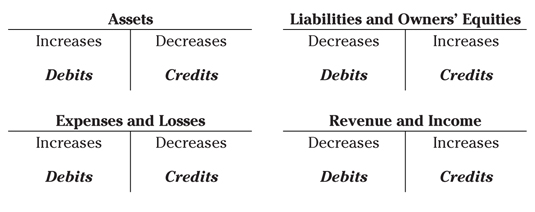As the business manager, you’re in control of your business’s accounting needs, so you need a strong understanding of the ins and outs of financial statements, including what goes on them and in what order. If you don’t prepare them correctly, they won’t reflect a true picture of your business’s financial status. Keep the following important rules and points in mind as you prepare and use your business’s financial statements.
Accounting equation
Assets = Liabilities + Owners’ Equity
Liabilities and owners’ equity are the two basic types of claims on the assets of an entity. The two-sided nature of the accounting equation is the basis for double entry accounting that records both sides of the entity’s transactions — what is received and what is given in the economic exchange.
Rules for debits and credits
Use the following figure for credit and debit basics:

Financial effects of revenues and expenses
Revenue = Asset increase (debit) or Liability decrease (debit)
Expense = Asset decrease (credit) or Liability increase (credit)
Connections between income statement and balance sheet accounts
Sales revenue → Cash and Accounts receivable
Cost of goods sold expense ← Inventory
Operating expenses → Cash
Operating expenses ← Prepaid expenses
Operating expenses → Accounts payable
Operating expenses → Accrued expenses payable
Depreciation expense ← Fixed assets
Interest expense → Accrued expenses payable
Income tax expense → Accrued expenses payable
Bookkeeping cycle
Transactions (and certain other events) → Original Entries in Journals → Postings in General Ledger Chart of Accounts → End-of-Period Adjusting Entries → Preparation of Financial Statements, Tax Returns, and Internal Accounting Reports → Closing Entries at End of Year
dummies
Source:http://www.dummies.com/how-to/content/formulas-and-functions-for-financial-statements.html
No comments:
Post a Comment